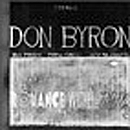


Don Byron
Romance with the Unseen
Rarely do musicians with Don Byron's status and notoriety venture into as many strikingly contrasting musical situations as he has in the last 10 years. Strongly associated with the New York avant garde, Byron has been a sideman with such jazz pioneers as Anthony Braxton and Leroy Jenkins, in addition to leading many ensembles and collaborations of his own with musicians like David Murray and Ralph Peterson. His recent release, Bug Music, was widely acclaimed by critics and public alike, and after performing at New York's center of avant garde music, the Knitting Factory, Byron received attention from MTV, exposing him to a completely new audience.
His latest album is, to a great extent, a step into the rarely visited world of straight-ahead jazz with the help of three musicians who also tend to dwell in the gray area between traditional and experimental music, Bill Frisell, Drew Gress and Jack DeJohnette. This is not to say that this album does not at times stretch the limits of structured jazz, nor are the musicians performing with Byron unfamiliar with his background or concepts.
The album's opening track, "A Mural From Two Perspectives," is a standard Duke Ellington composition which contains three brilliantly developed solos from Byron, Gress and Frisell. For the first time in a long while, the be-bop vocabulary flows fluently from the lips and fingers of these three typically "out" musicians. The two other pieces on the album from the jazz musicians' standard repertoire, are given anything but a standard interpretation. Herbie Hancock's "One Finger Snap" drifts from one soundscape to another with only vague references to the composed melody, and the melody to Juan Tizol's classic "Satin Doll" is nowhere to be found in their rendition, instead replaced by a quirky interpolated melody and reharmonization. The remainder of the album is comprised of six of Byron's own compositions and a classic Beatles tune, "I'll Follow the Sun."
Byron's writing is both intense and introspective, evoking a wide range of emotions and moods. (This is particularly true on the album's last cut, "Closer to Home.") While well performed in its own right, the interpretation of "I'll Follow the Sun" seems out of place and less passionately performed then the rest of the album, which is focused and emotionally draining. Byron's compositions cover a wide range of moods and styles from the Coltrane-esque "Bernard Goetz, James Ramseur and Me," to the minimalist piece, "'Lude."
Despite a few momentary lapses in taste on the part of the ensemble, this album is solid and cohesive from beginning to end. It is always refreshing to hear pioneering musicians of the avant-garde mingle their insights and concepts in the all too often stagnant world of contemporary traditional jazz.
Copyright © 1999, The Oberlin Review.
Volume 128, Number 11, December 3, 1999
Contact us with your comments and suggestions.